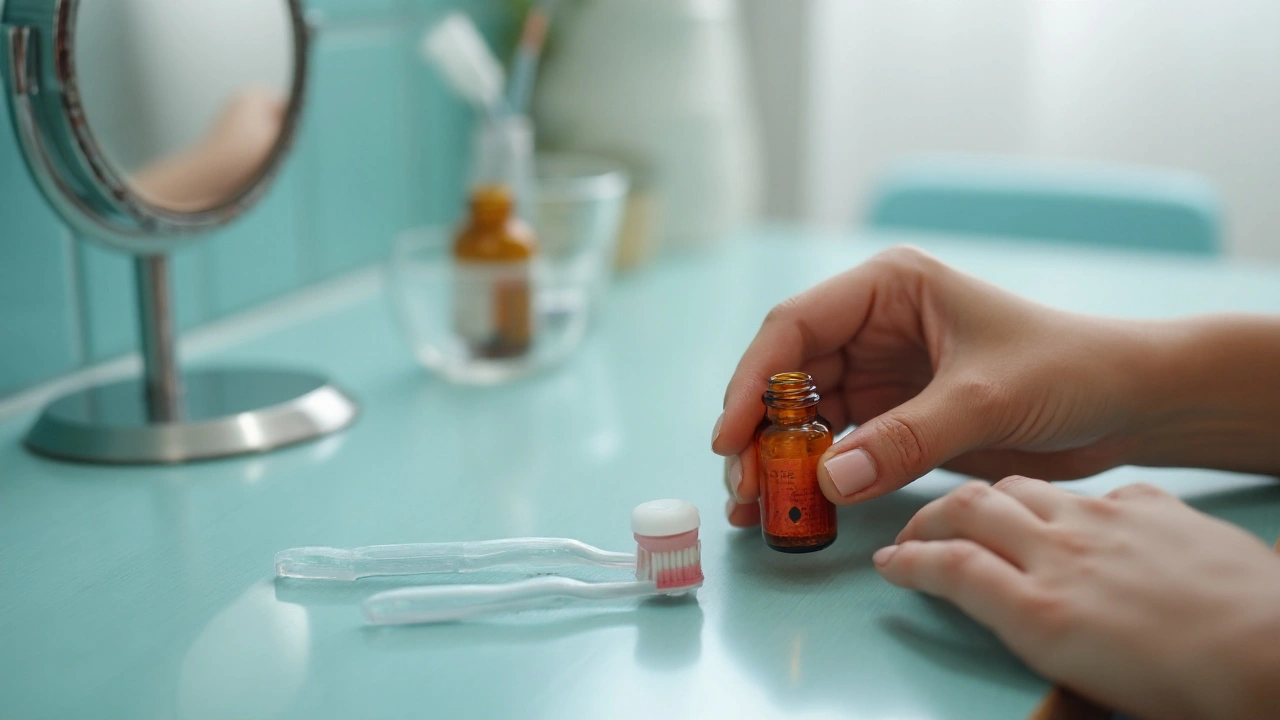Atrial Fibrillation is a cardiac arrhythmia that causes irregular, often rapid heartbeats, raising the risk of stroke and heart failure. When an dental procedure any oral surgery, cleaning, or extraction performed by a dentist or oral surgeon meets a patient with AF, the biggest concern is bleeding, especially if the patient is on anticoagulant medication drugs that thin the blood to prevent clots, such as warfarin or direct oral anticoagulants (DOACs). This article walks you through what you need to know before, during, and after the dental visit, using real‑world examples and evidence‑based recommendations from the American Heart Association leading authority on cardiovascular health guidelines.
Why AF Changes the Dental Playbook
AF itself does not make teeth bleed, but the stroke‑prevention drugs prescribed for AF do. The two most common drug families are:
- Warfarin a vitamin K antagonist that requires regular INR monitoring.
- Direct Oral Anticoagulants (DOACs) including apixaban, rivaroxaban, dabigatran, and edoxaban; they have fixed dosing and no routine lab checks.
Both groups increase bleeding time, but they differ in half‑life, reversibility, and the way clinicians assess safety before cutting a tooth.
Assessing Bleeding Risk: The INR and CHA₂DS₂‑VASc Scores
If you’re on warfarin, your dentist will likely ask for the International Normalized Ratio (INR) a lab value that measures how long it takes blood to clot relative to a standardized control. An INR between 2.0 and 3.0 is typical for AF; most dental societies deem an INR ≤3.5 safe for simple extractions.
For patients on DOACs, the key is timing the dose. The CHA₂DS₂‑VASc score a clinical tool that predicts stroke risk in AF patients helps decide whether skipping a dose is acceptable. A low score (0-1) often allows a short drug holiday, while a high score may require a more cautious approach.
Pre‑Appointment Checklist for Patients with AF
- Gather a recent INR report (if on warfarin) and a medication list that includes dose and timing.
- Ask your cardiologist whether a dose‑skip is safe for the planned procedure.
- Inform the dental office of any history of uncontrolled hypertension, recent cardioversion, or implanted devices (e.g., pacemaker).
- Bring a copy of the American Heart Association guideline summary for managing anticoagulation during dental care in case the dentist needs quick reference.
What Happens Inside the Dental Chair
During the visit, the dentist or oral surgeon will take several steps to minimise bleeding:
- Use local anesthesia with epinephrine which constricts blood vessels and reduces intra‑operative bleeding.
- Apply tranexamic acid mouthwash an antifibrinolytic that stabilises clots on the wound surface after extraction.
- Choose a suturing technique that promotes rapid clot formation, especially for larger sockets.
For patients on DOACs, many clinicians ask the patient to take the dose the night before and skip the morning dose, creating a 12‑hour “drug‑free window.” Warfarin patients rarely need to stop the drug if the INR is in range.
Post‑Procedure Care: Keep the Bleed in Check
After the procedure, the following routine helps prevent delayed bleeding:
- Gently bite on a gauze pad for 30‑45 minutes; replace if it becomes soaked.
- Resume normal anticoagulant dose as directed by the cardiologist-usually the same day for DOACs, unless the dentist advised otherwise.
- Rinse with a 0.5% tranexamic acid solution three times daily for 5 days if you have a high bleeding tendency.
- Contact the dental office immediately if you notice persistent oozing, large clots, or swelling.
John, a 68‑year‑old retired teacher with AF on warfarin (INR 2.7), needed a molar extraction. His dentist confirmed the INR was acceptable, used epinephrine‑rich lidocaine, and placed a tranexamic acid gauze. John followed the post‑op plan, resumed warfarin that evening, and had no bleeding complications-a textbook outcome.

Medication Interactions You Shouldn't Overlook
Some common dental drugs can amplify anticoagulant effects:
- NSAIDs like ibuprofen or naproxen, which interfere with platelet function and may increase bleeding.
- High‑dose antibiotics such as clarithromycin, which can raise DOAC plasma levels.
Instead, dentists often prescribe acetaminophen for pain and consider a short course of amoxicillin for infection control, both of which have minimal impact on clotting.
Choosing the Right Anticoagulant Strategy: A Quick Comparison
| Attribute | Warfarin | DOACs (e.g., apixaban) |
|---|---|---|
| Monitoring | Requires regular INR checks | No routine lab monitoring |
| Half‑life | 36‑48 hrs | 8‑12 hrs |
| Reversal Agent | Vitamin K, PCC | Andexanet alfa (apixaban), idarucizumab (dabigatran) |
| Typical Dental Safety Threshold | INR ≤3.5 for simple extraction | Take dose the night before; skip morning dose for high‑risk procedures |
| Bleeding Risk | Moderate, predictable | Slightly lower for minor work, but higher if dose not timed |
The table shows that neither drug class is “dangerous,” but each demands a specific workflow. Your dentist’s familiarity with the chosen anticoagulant determines how smooth the visit will be.
Connected Topics Worth Exploring
Understanding AF and dental care opens doors to broader subjects such as:
- cardioversion a procedure to restore normal rhythm, often considered before invasive dental work for unstable patients.
- prosthetic heart valves require lifelong anticoagulation, influencing dental treatment plans.
- The role of the dental hygienist in maintaining oral health to reduce inflammation that can trigger AF episodes.
- How sedation dentistry uses conscious sedation, which may interact with beta‑blockers or calcium‑channel blockers used for patients with severe AF.
Each of these areas adds depth to the conversation and can guide future reading.
Take‑Away Checklist for a Safe Dental Visit
- Confirm your INR (if on warfarin) within 24 hours before the appointment.
- Discuss dose timing with your cardiologist if you use a DOAC.
- Ensure the dental team knows you have AF and the specific anticoagulant.
- Ask about local measures (epinephrine, tranexamic acid) to control bleeding.
- Follow post‑procedure instructions exactly; resume medication as advised.
Following this roadmap gives you confidence that your smile can stay bright without jeopardising heart health.
Frequently Asked Questions
Can I get a tooth pulled while on warfarin?
Yes, as long as your INR is 3.5 or lower. The dentist will use local hemostatic measures and may ask you to hold the dose the night before for major surgeries.
Do DOACs need to be stopped for a cleaning?
Routine cleanings are low‑risk, so you usually continue the medication. If the cleaning will involve deep scaling or periodontal surgery, the dentist may suggest skipping the morning dose.
What if my INR is above 3.5 on the day of extraction?
Contact your cardiologist right away. They may adjust the warfarin dose or give vitamin K to bring the INR down before the procedure.
Are there any toothbrushes or oral care products that help AF patients?
A soft‑bristled toothbrush and alcohol‑free mouthwash reduce gum irritation, which can lower inflammation‑driven AF triggers.
Should I tell my dentist about beta‑blockers or calcium‑channel blockers?
Yes. These medications affect heart rate and blood pressure, influencing sedation choices and stress‑management during dental work.







19 Comments
so like... what if the dentist is just a shill for Big Pharma and they're secretly using epinephrine to trigger AF episodes? 😈 I saw a video where a guy got a filling and then his heart did the cha-cha. #DentistConspiracy
This is one of the clearest guides I've read on AF and dental care. The table comparing warfarin and DOACs is gold. Thanks for including the practical tips like tranexamic acid mouthwash - I wish more dentists knew this.
I've had three extractions on warfarin. INR checked the day before, no issues. Just follow the checklist. Simple.
Honestly, this article saved me so much anxiety. I'm on apixaban and was terrified to even think about a cleaning. The part about skipping the morning dose for high-risk procedures? Lifesaver. Also, the soft-bristled brush tip? Genius. I just bought one. My gums haven't been this calm in years. 🙌 And yes, I told my hygienist about my AF - she actually knew what DOACs were. Shocking, I know.
This is basically a 2000-word ad for DOACs. Where's the data on long-term bleeding risks? Also, why no mention of cost disparities? If you're on Medicare, warfarin is $4 a month. Apixaban? $500. This isn't 'evidence-based' - it's pharma-funded.
The author clearly hasn't read the 2023 ESC guidelines. DOACs aren't 'safer' - they're just less monitored. And tranexamic acid? Cute. But in India, we use alum powder. Works better. And cheaper. This is Western medical theatre.
Let’s be real: the AHA is a puppet of the anticoagulant industry. They push DOACs because they’re profitable. INR monitoring is a dying art because labs don’t make money off it. Dentists are being trained to skip labs and trust algorithms - which are trained on biased data. This isn’t medicine. It’s algorithmic capitalism with a stethoscope.
I work in a dental office in Texas and I’ve seen it all. Some of these patients think they’re too important to get an INR. One guy came in with an INR of 6.8 and said 'I don’t need no paper, I feel fine.' Bro, you’re gonna bleed out on my chair and then sue us. This isn’t Canada. We don’t coddle people who ignore medical advice. If you’re on warfarin, get your blood tested. Period.
I appreciate the tone here. It’s rare to see a medical post that doesn’t make you feel like a liability. I’ve got AF and a pacemaker, and my dentist always asks if I’m okay to be there. That small human touch matters more than any guideline.
Wait... so you're telling me the government doesn't want us to know that fluoride + anticoagulants = silent heart damage? I've been reading forums. People are dropping dead after cleanings. They call it 'routine' - but it's not. It's a cover-up. Your dentist is a sleeper agent for the blood-thinner cartel. Check your INR... or don't. I'm not your mom.
Just don't go to the dentist if you're on blood thinners. Simple.
My uncle had a tooth pulled on warfarin and had zero issues. He’s 76, lives in Kerala, no fancy labs, just a good dentist who knew what to do. Sometimes the best care isn’t the most high-tech - it’s the most thoughtful.
The intersection of cardiovascular physiology and oral mucosal biology presents a fascinating epistemological dilemma. The Western biomedical paradigm, rooted in reductionist pharmacology, often overlooks the holistic interplay between systemic inflammation and periodontal homeostasis. One must question whether the clinical protocols outlined herein truly address the ontological roots of atrial fibrillation, or merely its symptomatic manifestations.
I'm on rivaroxaban and my dentist didn't even ask about it 😭 I almost died after a cleaning. Now I carry a laminated card. #DentistFail
i read this and thoght wow this is so helpful but wait what is doac again? is that like a new kind of toothpaste?
Thank you for writing this with such care. I’ve been living with AF for 8 years and this is the first time I’ve felt like someone actually understood the fear behind every dental appointment. I cried reading the checklist. I’m printing it out and taking it to my next visit. You made me feel seen.
They’re hiding something. Why do all the guidelines say 'no need to stop DOACs for cleanings' but the FDA warning says 'risk of fatal hemorrhage'? Coincidence? I think not. They’re using dental offices as testing grounds. I’ve got a camera in my mouth now. I know what I saw.
I’m a dental hygienist in Scotland and I’ve been doing this for 22 years. The most important thing isn’t the INR or the DOAC - it’s listening. Patients with AF are terrified. They don’t need jargon. They need to feel safe. A calm voice, a warm hand, and asking 'What’s your biggest worry about this visit?' changes everything.
I’ve been thinking... what if AF isn’t a disease at all? What if it’s your body’s way of saying 'I’m tired of being medicated'? I stopped my warfarin last year and now I meditate every morning. My heart is calmer. The dentist didn’t even notice. Maybe the real treatment is silence, not science. 🌿✨
Write a comment